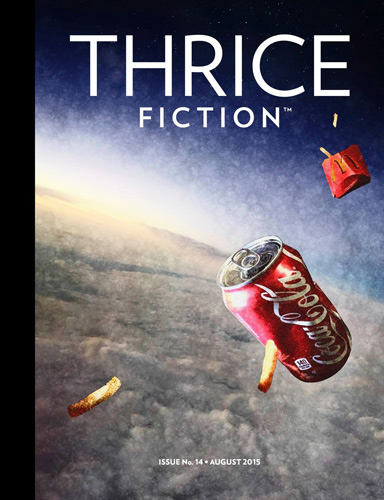Thrice Fiction – August 2015
With three issues a year, publishing fiction, Thrice Fiction is up-front and in-your-face, and not just when it comes to what genre it publishes and when. Its content is just as in-your-face with larger-than-life writing, and with full-color art donning almost every page. With three issues a year, publishing fiction, Thrice Fiction is up-front and in-your-face, and not just when it comes to what genre it publishes and when. Its content is just as in-your-face with larger-than-life writing, and with full-color art donning almost every page.
Eleanor Levine kicks off the August 2015 issue with her piece “Edgar Sinatra,” who “believed he was the son of Frank Sinatra, though it was rumored that a truck driver in his father’s plant was Edgar’s real father.” Darkly comedic, Edgar (or George when he’s on his medication) and the narrator have bad blood after an imagined slight, and their feud is funny and entertaining, but dark in all the right ways. A great pick for the first story, “Edgar Sinatra” (both the story and its eccentric namesake) sets a colorful stage for the rest of the issue.
Nicholas Olson in “T(w)omb” carries along a similar flavor, a piece wry and funny in moments and dark in the rest. Half a page long, “T(w)omb” follows main character Tomb after his eviction and the death of his parents, his father:
burned up and sprinkled over that one bus stop he used to wait at, or rather over the ground of same, which got icy and slick during wintertime. He’d be used as grit to prevent future accidents. It was his way of giving back to the world.
Lines like this are what really grabbed me, making me wish I could learn more about the mysterious Tomb, who we leave sleeping in his mother’s coffin after his campfire smokes him out of his tent. But it’s this variety of length in pieces which gives Thrice Fiction some of its flavor. Ray Nessly’s “Postcard” is just big enough to fit on a postcard, but pieces like Laurence Klavan’s “Destabilized” are several pages long, the variation in length creating a reading experience that’s never boring.
The sense of humor present throughout the issue contributes to this colorfulness, including Reza Farazmand’s “Poorly Drawn Lines” comics. Already a fan, I was happy to see three comics included: “How Cool,” “Intelligent”, and “Friends.” Full of subtle humor and anti-humor in simple four- or five-paneled strips, Farazmand lets readers know how to tell if their dog is cool and how friendships work between eagles and field mice. Perfectly quirky, “Poorly Drawn Lines” fits in well with the rest of the issue.
There’s never room to make assumptions about what the next page of Thrice Fiction holds. John M. Bennett’s poetry hangs out at the bottom of a handful of pages scattered throughout the issue, and different styles of art are paired with a wide array of voices. In the Editor’s Note, RW Spryszak welcomes readers into their “usual mayhem,” and that’s probably the best way to put it. Thrice Fiction is chaotic, colorful mayhem, great for the reader who needs a break from the mundane.
[www.thricefiction.com]





